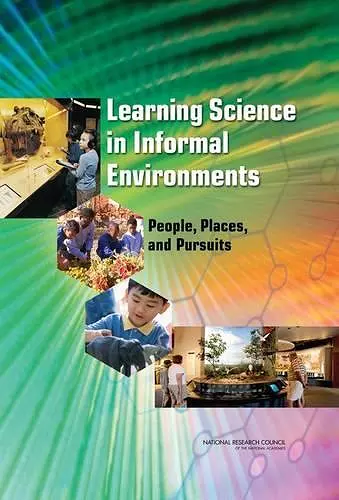Learning Science in Informal Environments
People, Places, and Pursuits
National Research Council author Division of Behavioral and Social Sciences and Education author Center for Education author Board on Science Education author Committee on Learning Science in Informal Environments author Andrew W Shouse editor Michael A Feder editor Bruce Lewenstein editor
Format:Hardback
Publisher:National Academies Press
Published:27th Jun '09
Currently unavailable, and unfortunately no date known when it will be back

Informal science is a burgeoning field that operates across a broad range of venues and envisages learning outcomes for individuals, schools, families, and society. The evidence base that describes informal science, its promise, and effects is informed by a range of disciplines and perspectives, including field-based research, visitor studies, and psychological and anthropological studies of learning.
Learning Science in Informal Environments draws together disparate literatures, synthesizes the state of knowledge, and articulates a common framework for the next generation of research on learning science in informal environments across a life span. Contributors include recognized experts in a range of disciplines—research and evaluation, exhibit designers, program developers, and educators. They also have experience in a range of settings—museums, after-school programs, science and technology centers, media enterprises, aquariums, zoos, state parks, and botanical gardens.
Learning Science in Informal Environments is an invaluable guide for program and exhibit designers, evaluators, staff of science-rich informal learning institutions and community-based organizations, scientists interested in educational outreach, federal science agency education staff, and K-12 science educators.
- Front Matter
- Summary
- Part I: Learning Science in Informal Environments
- 1 Introduction
- 2 Theoretical Perspectives
- 3 Assessment
- Part II: Venues and Configurations
- 4 Everyday Settings and Family Activities
- 5 Science Learning in Designed Settings
- 6 Programs for Young and Old
- Part III: Cross-Cutting Features
- 7 Diversity and Equity
- 8 Media
- Part IV: Conclusions, Recommendations, and Future Directions
- 9 Conclusions and Recommendations
- Appendix A: Biographical Sketches of Committee Members and Staff
- Appendix B: Some Technical Considerations in Assessment
- Index <
ISBN: 9780309119559
Dimensions: unknown
Weight: unknown
348 pages